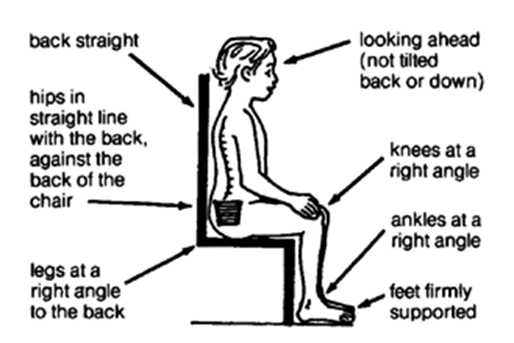Helping your child develop good eating skills:
- Self-feeding is a complex skill to learn. It is very common for children to find it hard to learn to use cutlery, or to stay clean!
- Allow plenty of time and use lots of praise, develop and correct one area at a time.
- Use different food textures ranging from very hard to soft to enable your child to practice grading the force of movement needed for cutting.
- Focus on skills more at the weekend when there aren't the pressures of a school and work day , start by asking your child to cut up food for the first minute / 2 mouthfuls, and then increase as your child’s ability improves.
- Use of appropriate size cutlery or cutlery with chunky handles or caring cutlery may help your child grip cutlery better.
- Heavy plates and bowls can be helpful and prevent knocking them off the table or use a non-slip mat or blue tac to support the bowl/plate to stop it from moving.
- Use of a plate guard or manoy plates may be useful your child is chasing food around the plate trying to scoop it up.
- Only fill half the cup if spilling is a problem.
- Prompt correct grip in the cutlery as this will improve control. As well as encourage using the fork to stabilise the food and the knife to ‘saw’ forward and back.
- If the your child will accept physical help, stand behind them and help the hand with the fork in to stay still while the knife moves back and forth across the food.
The Best Position:
Children should be sitting with their hips, knees, and ankles all bent at 90 degrees (90/90/90). Arms should be able to rest supported on the table.

Why is it important:
How and where the child eats' is important, and can have a huge impact on the success of mealtimes, ensuring the child is sat at the table with in a supportive seat will help.
If the child is not seated correctly they may have more difficulty with swallowing which can lead to choking.
Without good trunk support eating may be exhausting, therefore they may try to avoid eating meals, or end meal time sooner than they would have.
Having a poor sitting position can often leave children fidgety, moving frequently within the chair e.g. changing position often, sitting on their legs, falling off the chair, leaning on the table or other chairs. These behaviours can also make it harder for the child to focus on their meal and can be challenging and distracting for the parent/carers.
Equipment to help with positioning at the table
Highchairs:
For younger children the most effective piece of equipment is a high chair, preferably height adjustable to enable you to move the high chair to table level when needed. The high chair allows your child to maintain a 90/90/90. Ensure the high chair has a foot plate, to prevent their feet from dangling.
Booster Seats:
Provide good postural support and stability. Whilst also ensuring they are at the correct height of the table when eating.
Junior dining chairs:
This allows the child to be at the correct height in relation to the table and provide a bar for the child to rest their feet on.
Steps:
If the child’s feet aren’t firmly on the ground, place a low stool, children’s chair or step under them.
Supportive equipment:
For some children who have additional needs or medical conditions including cerebral palsy, muscular dystrophy, etc, the same principles apply with regards to position when eating. However they may benefit from having additional supportive seating to help maintain this position. A referral to occupational therapy at the Child Development Centre or Redgrave Gardens can provide equipment advice for school. A referral to the social service occupational therapy will enable seating provisions to be provided for home based on the child’s needs.
Children who need more postural support:
If your child has low muscle tone in their trunk, having additional support when they are sitting is more critical, to ensure they maintain an appropriate posture and maximise their eating skills. Children who may not feel they have enough support when sitting at the table may carry out the following behaviours:
- Will not sit on the chair.
- Wrap their legs around the chair legs
- Lean back against the chair
- Lean on the table
How to improve core stability:
Provide opportunity to engage in activities that encourage the development of core stability including:
- Swimming / Balance activities / Park / soft play
Core Stability exercises including:
- Bridge
- Superman
- Four point kneeling with arm and leg stretched out
- Crab walking
- Standing on one leg
- Wheelbarrow walks
Activities:
- Introduce cutlery in play, practice cutting up with play dough.
- Practice scooping dried peas or rice using a spoon and transfer them into another container to help develop spoon control and eye-hand coordination
- Allow your child to engage in food preparation, baking, and practice pouring and making drinks to help with learning skills.
- Construction games / using scissors / colouring / using a dustpan and brush—keeping the dustpan still and moving the brush
- Any games / activities which encourage the child to hold one hand still while moving the other hand will help the foundation skills for cutlery.
Resources / Websites:
www.amazon.co.uk — for plate guard, caring cutlery, manoy plate, non-slip matting.
Remember:
Is your child sat at the table in the 90/90/90 position with their feet, thighs and back supported?
Self Feeding is a complex skill to learn, practice one element of this skill at a time and ensure your child knows they are succeeding, use lots of praise and allow plenty of time.
Try to not let mealtimes become a ‘battle ground’ stress free practice is best.
To view this page as a downloadable PDF please click
here.